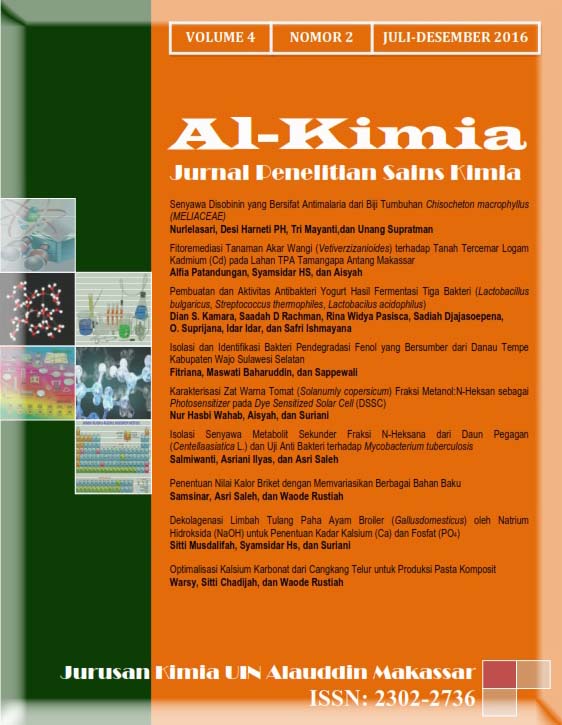Pembuatan Dan Aktivitas Antibakteri Yogurt Hasil Fermentasi Tiga Bakteri (Lactobacillus bulgaricus, Streptococcus thermophilus, Lactobacilus acidophilus)
Abstrak
Exploitation of synthetic antibiotics compounds not only have positive effect for human, but also have side effect that can be unfavorable, therefore many researches are being conducted to find natural antibiotics compounds that are safer. Lactic acid bacteria has the abilitytoproduce antibacterial compound when used in fermentation process.For example, Lactobacillus acidophilus produces acidophilin and acidolin. The main purpose of the present study is to investigate antibacterial activity of yogurt fermented with mixed bacterial culture of L. bulgaricus, S. thermophilus and L. acidophilus against Escherichia coli (representing Gram negative bacteria) and Bacillus subtilis (representing Gram positive bacteria). The antibacterial activity of the yogurt at three different time points (5, 7 and 9 hours) were examined. We also investigate the fermentation parameters of the yogurt production. The results of the present study indicate that the crude yogurt extract has antibacterial activity, where the highest activity was observed at 7 hour of incubation, resulting 0.35 and 0.30 cm of clear zone against E. coli and B. subtilis, respectively. It is most likely that the compound is non protein compound.
##plugins.generic.usageStats.downloads##
Referensi
Allgeyer, L.C., Miller, M.J.,and Lee, SY., 2010, Sensory and microbiological quality of yogurt drinks with prebiotics and probiotics, Journal of Dairy Science, 93(10): 4471-4479.
Arqués, J.L., Fernández, J., Gaya, P., Nuñez, M., Rodrıguez, E.,and Medina, M., 2004, Antimicrobial activity of reuterin in combination with nisin against food-borne pathogens, International Journal of Food Microbiology, 95(2): 225-229.
Chick, H., Shin, H.S.,and Ustunol, Z., 2001, Growth and Acid Production by Lactic Acid Bacteria and Bifidobacteria Grown in Skim Milk Containing Honey, Journal of Food Science, 66(3): 478–481.
Chuayana Jr., E.L., Ponce, C.V., Rivera, M.R.B.,and Cabrera, E.C., 2003, Antimicrobial Activity of Probiotics from Milk Products, Philippine Journal of Microbiology and Infectious Diseases, 32(2): 71-74.
Food Standards Australia New Zealand, 2014, Standard 2.5.3 Fermented milk products.
Gomes, A.M.P., Malcata, F.X., 1999, Bifidobacterium spp. and Lactobacillus acidophilus: biological, biochemical, technological and therapeutical properties relevant for use as probiotics, Trends in Food Science & Technology, 10(4): 139-157.
Goraya, M., Ashraf, U.M., Ur-Rahman, S., Raza, A.,and Habib, A., 2013, Determination of antibacterial activity of bacteriocins of lactic acid producing bacteria, Journal of Infection and Molecular Biology, 1: 1-7.
Ishmayana, S., Juanda, A., Suprijana, O., Djajasoepena, S., Idar,
I.,dan Rachman, S.D., 2015, Pengaruh Konsumsi Yogurt Yang Dibuat Dengan Kultur Dua Bakteri (Sterptococcus thermophillus dan Lactobacillus bulgaricus) dan Tiga Bakteri (Sterptococcus thermophillus, Lactobacillus bulgaricus dan Lactobacillus acidophilus) Terhadap Kadar Kolesterol Seru, Chimica et Natura Acta, 3(3): 94-99.
Jeon, J.-R., Kim, J.-Y., and Choi, J.-H., 2007, Effect of Yam Yogurt on Colon Mucosal Tissue of Rats with Loperamide-induced Constipation,FoodScience and Biotechnology, 16(4): 605-609.
Meyer, A.L., Micksche, M., Herbacek, I.,and Elmadfa, I., 2006, Daily Intake of Probiotic as well as Conventional Yogurt Has a Stimulating Effect on Cellular Immunity in Young Healthy Women,Annals of Nutrition and Metabolism, 50(3): 282–289.
Rachman, S.D., Djajasoepena, S., Indrawati, I., Bangun, L., Kamara, D.S. dan Ishmayana, S., 2016, Penentuan Kadar Riboflavin dan Uji Pendahuluan Aktivitas Antibakteri Yogurt yang Difermentasi dengan Bakteri yang Diisolasi dari Yogurt Komersial, Seminar Nasional Kimia dan Pembelajaran Kimia, Departemen Kimia, Universitas Padjadjaran, Jatinangor. 12 Mei 2016
Rachman, S.D., Djajasoepena, S., Kamara, D.S., Idar, I., Sutrisna, R., Safari, A., Suprijana, O., dan Ishmayana, S., 2015, Kualitas Yoghurt yang Dibuat Dengan Kultur Dua (Lactobacillus bulgaricus dan Streptococcus thermophilus) dan Tiga Bakteri (Lactobacillus bulgaricus, Streptococcus thermophilus dan Lactobacillus acidophilus), Chimica et Natura Acta, 3(2): 76-79.
Shah, N.P., 2006, Health Benefit of Yogurt and Fermented Milks, in R.C.
Chandan, C.H. White, A. Kilara, Y.H. Hui (eds.), Manufacturing Yogurt and Fermented Milks, Oxford: Blackwell Publishing.
Soukoulis, C., Tzia, C., 2008, Impact of the acidification process, hydrocolloids and protein fortifiers on the physical and sensory properties of frozen yogurt, International Journal of Dairy Technology, 61(2): 170-177.
##submission.copyrightStatement##
##submission.license.cc.by-nc-sa4.footer##Authors who publish with this journal agree to the following terms:
1) Authors retain copyright and grant the journal right of first publication with the work simultaneously licensed under a Creative Commons Attribution License that allows others to share the work with an acknowledgement of the work's authorship and initial publication in this journal.
2) Authors are able to enter into separate, additional contractual arrangements for the non-exclusive distribution of the journal's published version of the work (e.g., post it to an institutional repository or publish it in a book), with an acknowledgement of its initial publication in this journal.
3)Authors are permitted and encouraged to post their work online (e.g., in institutional repositories or on their website) prior to and during the submission process, as it can lead to productive exchanges, as well as earlier and greater citation of published work (See The Effect of Open Access).


